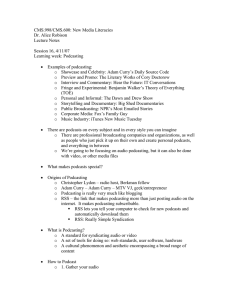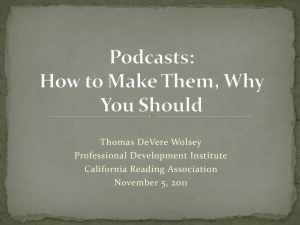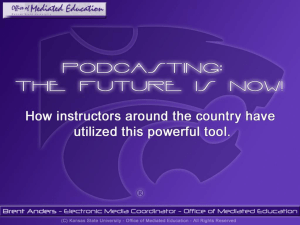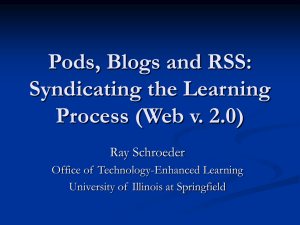What is a Podcast? Eastern Michigan University, 109 Halle Library
advertisement
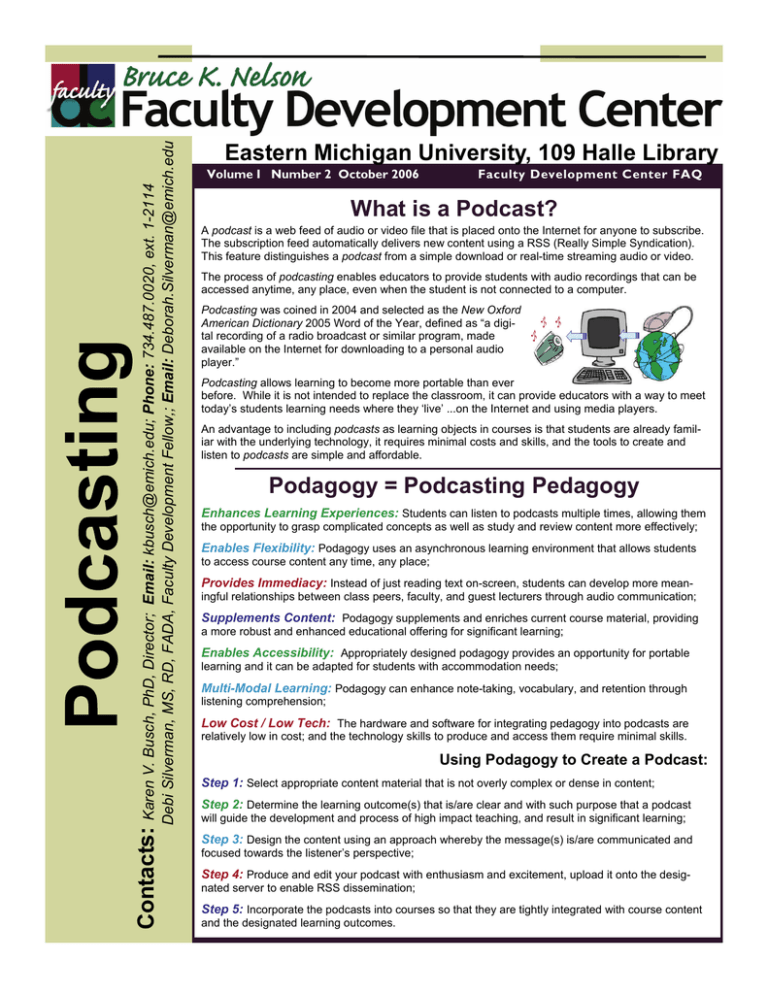
Email: kbusch@emich.edu; Phone: 734.487.0020, ext. 1-2114 Debi Silverman, MS, RD, FADA, Faculty Development Fellow,; Email: Deborah.Silverman@emich.edu Contacts: Karen V. Busch, PhD, Director; Eastern Michigan University, 109 Halle Library Volume I Number 2 October 2006 Faculty Development Center FAQ What is a Podcast? A podcast is a web feed of audio or video file that is placed onto the Internet for anyone to subscribe. The subscription feed automatically delivers new content using a RSS (Really Simple Syndication). This feature distinguishes a podcast from a simple download or real-time streaming audio or video. The process of podcasting enables educators to provide students with audio recordings that can be accessed anytime, any place, even when the student is not connected to a computer. Podcasting was coined in 2004 and selected as the New Oxford American Dictionary 2005 Word of the Year, defined as “a digital recording of a radio broadcast or similar program, made available on the Internet for downloading to a personal audio player.” Podcasting allows learning to become more portable than ever before. While it is not intended to replace the classroom, it can provide educators with a way to meet today’s students learning needs where they ‘live’ ...on the Internet and using media players. An advantage to including podcasts as learning objects in courses is that students are already familiar with the underlying technology, it requires minimal costs and skills, and the tools to create and listen to podcasts are simple and affordable. Podagogy = Podcasting Pedagogy Enhances Learning Experiences: Students can listen to podcasts multiple times, allowing them the opportunity to grasp complicated concepts as well as study and review content more effectively; Enables Flexibility: Podagogy uses an asynchronous learning environment that allows students to access course content any time, any place; Provides Immediacy: Instead of just reading text on-screen, students can develop more meaningful relationships between class peers, faculty, and guest lecturers through audio communication; Supplements Content: Podagogy supplements and enriches current course material, providing a more robust and enhanced educational offering for significant learning; Enables Accessibility: Appropriately designed podagogy provides an opportunity for portable learning and it can be adapted for students with accommodation needs; Multi-Modal Learning: Podagogy can enhance note-taking, vocabulary, and retention through listening comprehension; Low Cost / Low Tech: The hardware and software for integrating pedagogy into podcasts are relatively low in cost; and the technology skills to produce and access them require minimal skills. Using Podagogy to Create a Podcast: Step 1: Select appropriate content material that is not overly complex or dense in content; Step 2: Determine the learning outcome(s) that is/are clear and with such purpose that a podcast will guide the development and process of high impact teaching, and result in significant learning; Step 3: Design the content using an approach whereby the message(s) is/are communicated and focused towards the listener’s perspective; Step 4: Produce and edit your podcast with enthusiasm and excitement, upload it onto the designated server to enable RSS dissemination; Step 5: Incorporate the podcasts into courses so that they are tightly integrated with course content and the designated learning outcomes. Page 2 Visit us at: www.emich.edu/facdev How to Use Podcasts to Achieve Instructional Goals: Source: Podcasting @University of Wisconsin—Madison. Available at: http://engage.doit.wisc.edu/podcasting/teachAndLearn/ If your instructional goal is to: The focus of your podcast should be to: Prepare or motivate students for learning new content. Arouse interest and curiosity about a new topic to increase learner motivation. Inform students of the learning outcomes or benefits of learning new content. Influence feelings and attitudes about a topic prior to a lecture or reading assignment. Recall and integrate previously learned material with new content. Explain the connection between what students have previously learned with new content to be presented in a lecture or reading assignment. Provide a lead-in to an assignment or learning activity. Discuss in more detail what you expect of students from an assignment and how you suggest they best approach it. Elaborate on and further explain a complex concept. Explain nuances and intricacies of a difficult concept, principle, or abstract process. Provide content to encourage analysis. Provide a stimulus for students to react to or reflect upon for deeper analysis. Concerns and Possible Issues with Podcasts Students won’t come to class. Do not ‘course-cast’; use Podcasting to augment lectures or do not release them immediately after class. 80% of students surveyed at UCLA stated that Podcasting did not affect their attendance in a negative way; 87% wanted online lectures to be offered. Students listening to lectures in the classroom have been found to comprehend <50% of the basic matter. (Callaway, Purdue University) Students contend that taking notes during a lecture hampers their listening comprehension. An essential skill for good note-taking is good listening. Making podcasts available to students enables them to review notes taken in class for accuracy, fill-in the gaps, and/or review content as many times as necessary for total comprehension. Pedagogical / Technological Skills Prior to implementing Podcasting into your teaching you should be able to demonstrate skills to: • • • • • Identify and select courses in which podcasting will be utilized as digital media learning objects to support high impact teaching and learning; Select learning outcomes that enable the use of podcasting as learning objects or as components of the learning activities to achieve the designated significant learning outcomes; Design course content such that podcasts are utilized as an approach to communicate/share/enhance the content and support its pedagogy; Structure podcasts that adhere to copyright rules/regulations, focusing on important concepts or issues related to specific learner outcomes, and promoting high impact teaching and significant learning; Plan, process, and utilize collaboration to create accurate, creative content; organize and edit podcast content; targeting it to the audiences’ learning styles; create scripts and select appropriate blocking / segments when recording; and, display academic integrity and abide by legal regulations/requirements in its contents and RSS dissemination. Selected Resources on Podcasting and Podagogy • Meng, Peter. Podcasting & Vodcasting: A White Paper. University of Missouri, IAT Services, March, 2005. Available at: http://edmarketing.apple.com/adcinstitute/wp-content/ Missouri_Podcasting_White_Paper.pdf • Williamson, Jim. Introduction to Podcasting—Part 1: What is Podcasting?. UCLA Teaching Enhancement Center. Available at: http://www.oid.ucla.edu/units/tec/tectutorials/casting/whatispodcasting01 • Vogele, Colette. Garlick, Mia. The Berkman Center Clinical Program in Cyberlaw. Podcasting Legal Guide: Rules for the Revolution. Available at: http://wiki.creativecommons.org/Podcasting_Legal_Guide • Examples of podagogy at: University of California, Los Angeles: http://www.ucla.edu/rss/ and the University of Wisconsin: http://engage.doit.wisc.edu/podcasting/examples/
